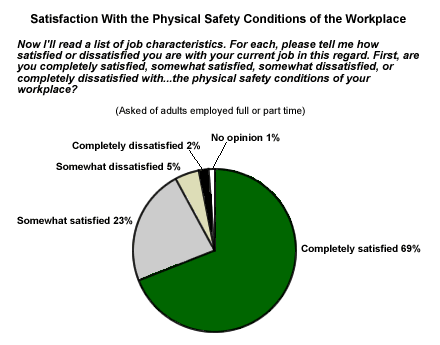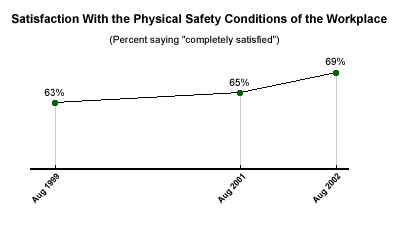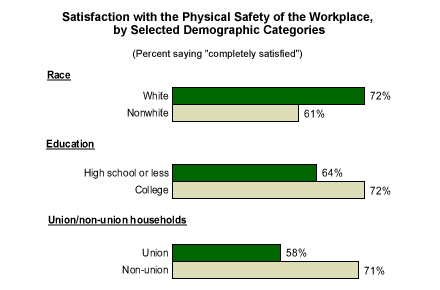In response to a recent Gallup poll on work and education issues*, 92% of employed Americans were found to be satisfied with the physical safety of their workplace, with 69% saying they were "completely satisfied." These numbers seem very high, particularly when compared to overall job satisfaction figures from the same poll -- 89% of employed Americans said they were satisfied, with 43% saying completely satisfied.

Further, ratings of workplace safety are on the rise in America -- since 1999, the percentage of workers completely satisfied with the physical safety conditions of the workplace has increased slightly from 63% to 69%.

Should Americans Feel Safe in the Workplace?
While satisfaction with safety in the workplace is improving, historically, the workplace has been a dangerous environment. The Centers for Disease Control and Prevention puts the cost of work-related injuries and fatalities at greater than $121 billion annually. Based on data from 1980 to 1992, the CDC estimates an average of 16 workers die every day from work-related injuries, and more than 17,000 are injured.
Many of these injured workers end up in hospital emergency departments, which makes a strong case for injury prevention programs. Occupational health programs should focus on more than executive and pre-employment physicals; these programs should also provide preventative education for workers on the leading causes of nonfatal occupational injuries such as falls, overexertion or improper contact with objects and equipment.
Who Is Most at Risk in the Workplace?
To help target workplace safety efforts, it may be helpful to review the data showing which groups among all American workers are most concerned about their physical safety conditions.

The data show that white employees are somewhat more likely than nonwhite employees to say they are completely satisfied with safety at their workplace. College graduates are slightly more likely to express complete satisfaction with the safety of their workplace than are those with a high school education or less (71% compared to 64%). Also workers in union households (58%) are less likely to be satisfied than those in non-union households (71%). These findings are consistent with the assumption that those with more physically demanding jobs or those who work with heavy machinery will tend to be most concerned about the level of safety where they work. CDC data point to higher risk of serious nonfatal injuries in the manufacturing sector, including shipbuilding, wooden building, foundries and meat packing plants.
What about the healthcare industry? The CDC figures also indicate that hospitals are among the types of workplaces experiencing the greatest numbers of serious nonfatal injuries. Safety in hospitals is not just a concern for patients, but also for employees. For example, the 2000 report from the Council on Scientific Affairs estimated there are 800,000 injuries to healthcare workers from needles and other sharp instruments every year.
Key Points
Gallup's 2002 data on workplace safety suggest the continuation of a trend toward improvement, but 3 in 10 workers are still less than completely satisfied with safety conditions on the job. These numbers are highly relevant to hospitals and other healthcare workplaces, where preventable injuries are particularly commonplace.
*Results are based on telephone interviews with 584 national adults, aged 18 and older, who are employed full time or part time, conducted Aug. 5-8, 2002. For results based on the total sample of employed national adults, one can say with 95% confidence that the maximum margin of sampling error is ±4%.